Mind Map Your Way to the Perfect Book Title
Sometimes the right title pops into your head in a flash of caffeine- and creativity-fuelled insight. If this is you, then you’re one of the lucky ones, my friend. For those times the writing gods aren’t on side, I have just the strategy to turn the tide.
It’s hard to define what makes a great title. There are powerful one-worders that pack a punch, like Stephen King’s It or Maggie Stiefvater’s Shiver. Then there are titles that go on and on but are perfect because of that, like Mark Haddon’s The Curious Incident of the Dog in the Night-Time and Catherynne M. Valente’s The Girl Who Circumnavigated Fairyland in a Ship of Her Own Making. And there’s every kind of title in between.
So where does that leave us, the weary writers trying desperately to find the right names for our babies? How do we overcome title block and find the perfect words to describe the outpouring of our souls? How do we brainstorm something that encapsulates the tale before us?
We start by forgetting everything we know about titles. Let me explain...
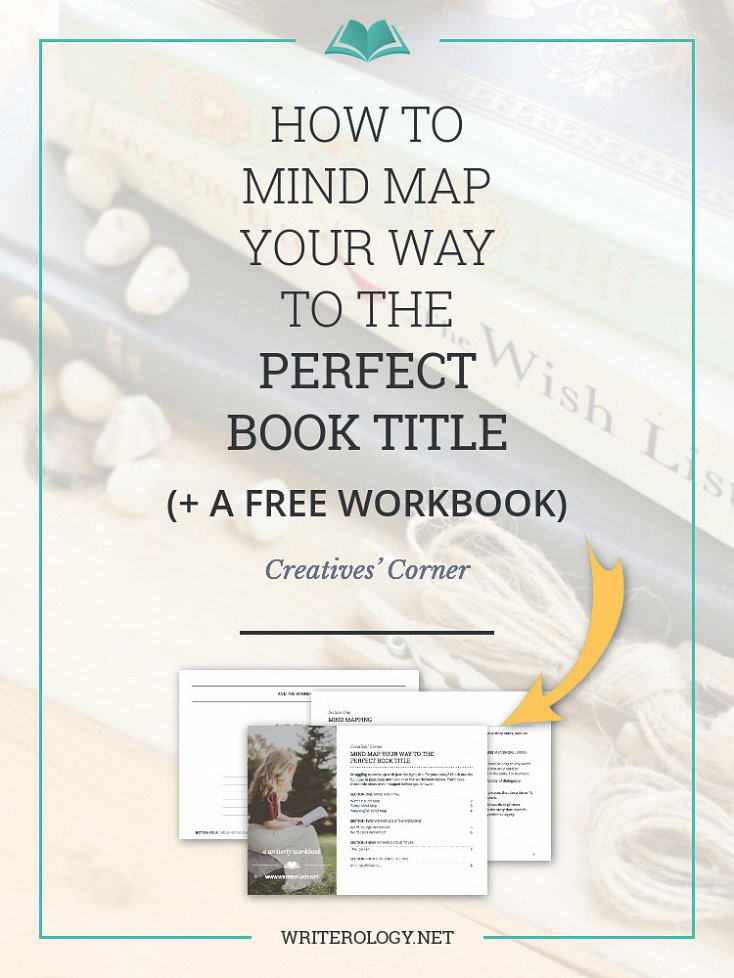
It’s easy to become overwhelmed when trying to come up with a title. It needs to be catchy, whispers that voice at the back of your mind. It needs to be clever or intriguing or funny. It needs to make readers pick it off the shelf.
And yes, good titles do these things—but if all you’re concentrating on at first is the perfect wording, you’re going to stall out, and anything you do scrape together is going to ring hollow. My advice? When you first start searching for that perfect title, forget about the wording. That comes later. Instead, focus on the most important feature of a good title: it reflects the heart of your story.
So how do you find out what’s at your story’s heart and shape that into something irresistible? I like to use this particular method:
STEP 1
Prep Your Materials
It’s mind map time! Use the Mind Map Your Way to the Perfect Title workbook I’ve put together for you or grab three pages to write on and put a bubble at the centre of each page, labelled ‘Names’, ‘Story’ and ‘Meaningful’ respectively. Here’s what my collection of mind maps looks like:
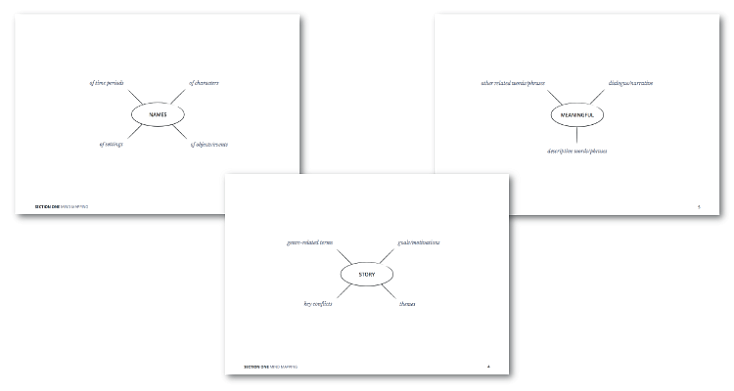
STEP 2
Let the Mind Mapping Begin
Read through your manuscript, beginning to end. (Don’t panic if you don’t have a complete draft written! While this strategy is most effective if you have at least a first draft done, you can use any material you do have written and your story notes instead. If so, I’d suggest going through the mind mapping process again once you’ve finished writing your book, just to make sure the story hasn’t changed so much the title no longer fits.)
As you read through your manuscript, use your mind maps to note down any words or phrases that fall into the three categories I mentioned previously, like so...
In The ‘Names’ Mind Map:
Write down the names of any important characters, places or things in your story as offshoots on this mind map. Here are some ideas to get you started:
- Jot down the name of your protagonist, your antagonist and any major figures in the narrative. (Example titles from popular literature: Oliver Twist by Charles Dickens, Carrie by Stephen King or American Gods by Neil Gaiman.)
- Sprouting off from those names, try other ways to describe or refer to the characters, like their titles, relationships or jobs. (For example, Audrey Niffenegger’s The Time Traveler's Wife or Laura Teagan’s The Assassin.)
- Take note of the name of the story’s main setting(s), any destinations the characters want to reach or locations that are referred to frequently. (For example, Wuthering Heights by Emily Brontë, The Well of Ascension by Brandon Sanderson or Miss Peregrine’s Home for Peculiar Children by Ransom Riggs.)
- Why not throw the time period in among your settings on the mind map too? (For example, 1984 by George Orwell or 11/22/63 by Stephen King.)
- And don’t forget the names of anything integral to the plot, like key objects or events, either! (For example, Philip Pullman’s The Amber Spyglass, Cornelia Funke’s Inkheart or Suzanne Collins’ The Hunger Games.)
Don’t worry about how any of these names look for now. Making them catchy or intriguing comes later. Just jot down anything that relates to the important names in your story and branch off from those with more ideas if and when they come to you.
Here’s what my ‘Names’ mind map looks like:
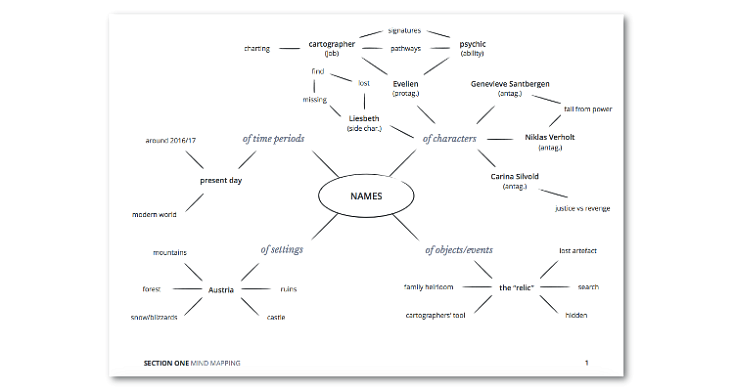
Click here to enlarge the image.
In The ‘Story’ Mind Map:
Now for your second mind map, the place to note down any important story elements. If the ‘Name’ category was the who, where and when of your story, this category is more the what and why. Here are a few ideas to get you started:
- Add any major themes you pick up on throughout the story to your mind map. (Example titles from popular literature: War and Peace by Leo Tolstoy or Atonement by Ian McEwan.)
- Write down any driving character goals or motivations you come across. (For example, Lian Hearn’s Across the Nightingale Floor or Keeping Faith by Jodi Picoult.)
- Note down any key conflicts, critical to the plot in some way. (For example, The Battle of the Labyrinth by Rick Riordan or Curse of the Bane by Joseph Delaney.)
- Why not include the story’s genre on the mind map too, with related key terms sprouting off from it? (For example, Heart of Brass by Kate Cross, ‘brass’ being related to the steampunk genre, or Magic Bites by Ilona Andrews, ‘magic’ being a key term in the fantasy genre.)
Again, we’re just brainstorming here, picking out the elements of the story that are crucial to the tale, elements that would fundamentally change the story if they weren’t present. Once we spruce up the wording a bit, it could be these elements that reflect the soul of your book.
Here’s what my ‘Story’ mind map looks like:
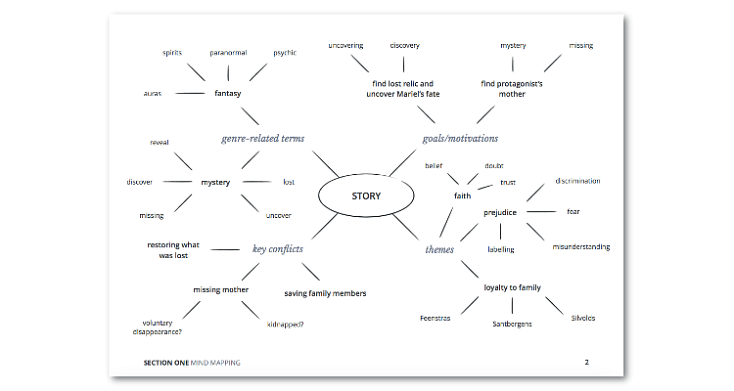
Click here to enlarge the image.
In The ‘Meaningful’ Mind Map:
This mind map belongs to any words or phrases that are pivotal or significant in the story. Ideally, they’ll be words/phrases that reflect a core element of the book, rather than just ones you picked purely because they sound cool or pretty or witty (but if they do both, that’s a bonus!). Don’t know where to start? Here are some ideas:
- Jot down any meaningful bits of dialogue or narrative. (Example titles from popular literature: Beautiful Creatures by Kami Garcia and Margaret Stohl or A Game of Thrones by George R.R. Martin.)
- Add any words/phrases that describe or fit the characters to your mind map too. (For example, Divergent by Veronica Roth or Valiant by Sarah McGuire.)
- Include any meaningful words/phrases relating to the story that don’t fit into any other category here too. (For example, Ink and Bone by Rachel Caine or Siege and Storm by Leigh Bardugo.)
This category probably gives the most creative freedom so get imaginative here and splurge any ideas you have on to your mind map, linking any related thoughts you have.
Here’s a peek at my ‘Meaningful’ mind map:
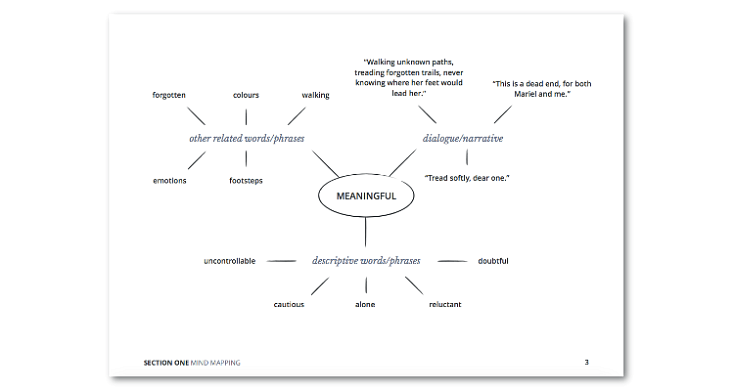
Click here to enlarge the image.
Now, some of the words and phrases you put in your mind maps may overlap different categories (like a significant bit of dialogue involving a place name or key conflict) so don’t be afraid to put those in both mind maps. They may generate slightly different titles for each category when we start tinkering with the wording.
Speaking of wording, let’s get on to that, shall we? Think of the words and phrases you’ve noted down so far as a leaping-off point. On their own, they may not be enough, which brings us to the next stage in our journey.
STEP 3
Work on the Wording
Remember how I said to forget wording earlier? Not anymore. Now let’s take the raw stones we mined in Step 2 and refine them into beautiful diamonds.
Grab another sheet of paper or the Working on the Wording pages in today’s downloadable workbook and get ready because you’re about to work some magic. That’s right; it’s time to create a list of possible titles.
Don’t panic! Just because we’re prettying up the words here doesn’t mean they have to be perfect yet. Experiment, play around with the wording and get as many title ideas down as you can, because the more options you have, the more likely you are to find The One.
Now, dear writers, I want you to consider carefully the type of words you’re using, as well as what words you’re using—both can influence how the title feels, and the title should feel how the book does (more on that in a moment). So word types—what am I talking about and why are they important?
Nouns
Nouns identify people, things, ideas, qualities or states—pretty much what you listed in the ‘Names’ mind map. Chances are, your title’s going to contain some of these. Will it be a powerful one-worder, like K.R. Thompson’s Pan or Scott Westerfeld’s Leviathan? Or will you sandwich your nouns in with other word types (e.g., verbs or adjectives), as with Harper Lee’s To Kill a Mockingbird?
Pronouns
You might also want to consider the use of pronouns (e.g., he, her, that, theirs, etc.) in your title to create a sense of ambiguity or mystery. Getting readers to question who the title is referring to could be just the hook you need to get them to pick up the book. Pronouns can also indicate the point-of-view the book is written from, so keep that in mind if you decide to use them. Some example titles to illustrate? All yours: Her Fearful Symmetry by Audrey Niffenegger and I Am Number Four by Pittacus Lore.
Verbs
Verbs can create a feeling of action and momentum, that things are happening and readers should pick up the book to find out what. If you want to create the impression the action is ongoing, consider using the present participle or gerund forms of a verb (that’s [verb]-ing) in your title. For example, John Green’s Looking for Alaska, Suzanne Collins’ Catching Fire or Stephen King’s The Shining. Including verbs in your title is also a great way to communicate character goals or motivations, which you might remember noting down in your ‘Story’ mind map.
Adjectives
Sometimes a noun on its own isn’t enough. Picking out the right adjectives (words that describe nouns) to add to those you’ve listed in your mind maps can give the reader another tantalising piece of information or add extra punch to any nouns you were thinking of using. To name a few examples from popular literature: A Thousand Splendid Suns by Khaled Hosseini, The Great Gatsby by F. Scott Fitzgerald and The Lovely Bones by Alice Sebold.
Though there are many more word types than those I’ve listed, these are the main ones that appear as the focus of titles so they’re what we’ll concentrate on now.
Okay, your turn. Grab the Working on the Wording section of the downloadable workbook and note down any ideas you have for titles. I’ve created two worksheets for you, one for scribbling down any title ideas you have, perfect if you just want to braindump on to the page (see the Word Splurge Worksheet), and one for writing down titles with different word class focuses, to get you thinking about emphasis and all the variations you might consider (see the Word Class Worksheet). Write down any ideas you have, playing with the wording to produce a list of possible titles to choose from. Aim to generate at least 20 possible titles here, if you can.
Not sure how to use the two worksheets? Here are mine as an example:
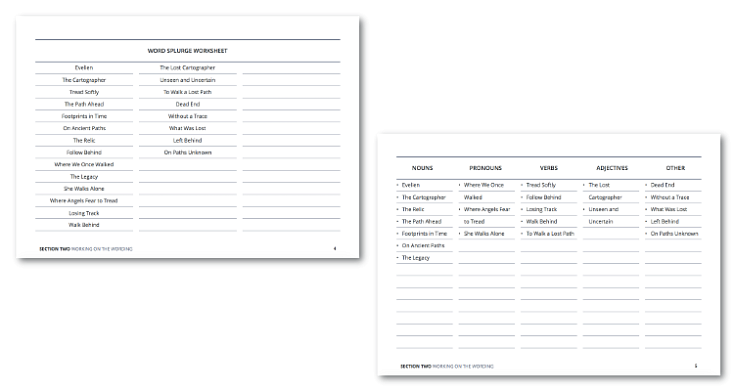
Click here to get a closer look.
Oh, and one last thing...
To Keep in Mind
While you’re tinkering with the wording of your book baby names, consider these important points:
- The style of your title will affect your readers’ expectations so keep your writing style consistent from title to story. Is your prose lyrical and poetic? Punchy or sharp-sounding titles probably won’t work then.
- When creating that list of title possibilities, think about words that are evocative. A title that stirs up emotions makes readers pick it up and remember it after they’ve put the book down.
- Genre can also affect title conventions. Long or unusual titles might be more commonplace in literary works or fantasy/sci-fi, while genres like thrillers and horrors tend to have shorter, sharper titles. Not sure what the conventions are in your genre? Go to Amazon and search for the top 20 books in your genre. What elements do they have in common?
- If your book is part of a series, it’s worth considering here whether you’ll make the titles for all the books related somehow. If so, will it be a word they all share? A common theme? A similar pattern? For example, the books in Garth Nix’s The Keys to the Kingdom series are all named after antagonistic characters, who themselves are named after days of the week. The books in Pittacus Lore’s Lorien Legacies series all have numbers in their titles. What, if anything, will your books’ titles have in common?
With those pointers in mind and a list of possible titles at your fingertips, let’s move on to the final stage.
STEP 4
Choose ‘The One’
All that’s left to do now is to pick the title from the list that speaks to your heart. And—surprise, surprise—I’ve created some worksheets to help you with that too. See the Refining Your Titles and the Choosing the One sections of the workbook.
My advice: don’t pick your final title straight away. Put your list in a drawer for at least a day before narrowing it down. (Got to get a little perspective, right?) Then, if no particular title jumps out at you, start by cutting out those that don’t work as well. Whittle your list down until you’re left with The One.
But, Faye, you may ask, what if I can’t narrow it down to one or I’m not sure which is the best title to use? Then, dear writer, I advise asking someone you trust for a second opinion. It could be a family member, a friend, a critique partner or your writing buddies. You could even set up a poll on social media so that your followers can vote for the one they like best.
Of course, this is only one way to brainstorm a title for your story. There are as many out there as there are people—everyone has their own process and you’ll probably want to tinker with mine so that it suits you better. And that’s okay. Tinker away, my friend.
Want help with that tinkering? Here’s that downloadable workbook again, to get you started in your journey.